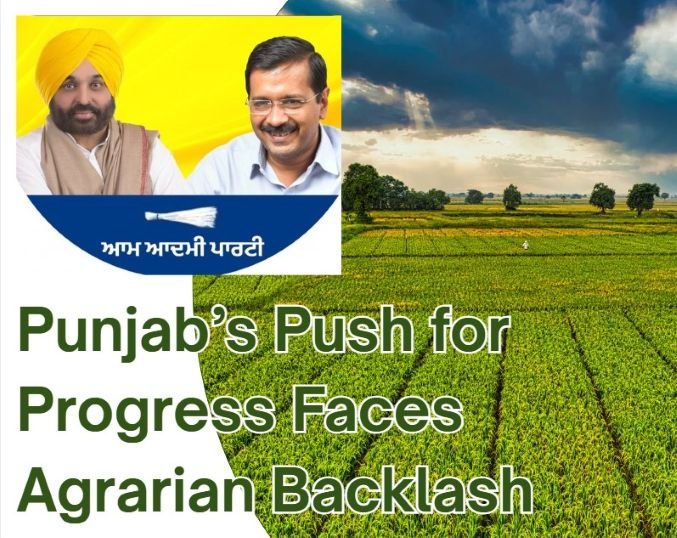Saptrishi Soni: Punjab—the land of lush fields, rich harvests, and deep-rooted agrarian identity—is witnessing a dramatic clash between development ambition and farmer resilience. On one side stands the state government’s bold Land Pooling Policy, 2025, designed to reshape urban landscapes; on the other, a swelling movement of opposition that calls into question whose progress it truly serves.
Introduced earlier this year, the policy sets out to acquire over 40,000 acres of farmland across cities like Ludhiana, Mohali, and Amritsar, turning them into planned urban hubs. The model is pitched as voluntary and collaborative: farmers would “pool” their land in exchange for a share of developed residential and commercial plots—far more valuable in urban form than bare fields. The idea is that it would accelerate urban expansion, rein in unplanned colonies, and unlock ₹20,000–25,000 crore in revenue to fund public schemes such as women’s monthly stipends. The government has described it as a path to “turn landowners into stakeholders” in Punjab’s future, and even promises an impressive 400% return on land value once development is completed .
Why the Government Is Betting on Land Pooling
Urban planners and state officials argue that Punjab faces a critical choice. Unchecked sprawl, occurring outside regulatory frameworks, has already claimed vast swathes of prime farmland, feeding the land mafia and costing public revenue. Traditional land acquisition under the 2013 Land Acquisition Act means court delays and inflated compensation—sometimes four times the collector rate—adding to public expense. In contrast, the land pooling model offers a faster, cost-effective route to deliver infrastructure while retaining state control under the 1995 Punjab Town Planning Act .
The policy’s champions—led by Finance Minister Harpal Singh Cheema—insist it’s voluntary, fair, and rooted in farmer consent. Cheema emphasizes that landowners will receive a fully developed residential plot of up to 1,000 sq yards plus 200 sq yards of commercial land for every pooled acre. He labels the policy a “decisive blow against the land mafia,” ushering in transparency and combating graft .
Harvesting Distrust: Why Protests Are Intensifying
Yet this vision of transformation isn’t yielding fertile ground. Instead, Punjab’s farming community is preparing for a fierce bloom of resistance.
At the heart of the backlash lies deep anxiety over loss of fertile soil. Punjab is India’s food-bowl, producing nearly 1.5 lakh tonnes of paddy annually. The land pooling progress threatens to stake its future on concrete at the expense of crops and climate resilience .
There is also growing alarm among small landholders. In Mohali, for example, participants discovered that one acre of land now buys just 150 sq yards of developed residential plot—long gone is the promise of 200 sq yards plus commercial space. Their relative share seems marginalised compared to large landowners and builders . With over 90% farmers rejecting pooling offers, only a few dozen have signed in key districts like Ludhiana and Mohali .
Additionally, the voluntary tag rings hollow for some. Despite assurances, farmers report pressure from local authorities and village councils, warnings about losing water rights, and being offered minimal interim compensation for the lengthy period before development yields results .
From Fields to Street: Political Cross-Fire
Perhaps most telling is the unprecedented political cohesion that has arisen in defiance of the scheme. On July 18 and 19, farmer groups under the Samyukt Kisan Morcha (SKM) convened all-party meetings in Bathinda and Chandigarh. Figures from the Congress, BJP, Shiromani Akali Dal, BSP, and leftist front joined hands to condemn the government’s land grab model and demand a rollback .
BJP’s entrance into the fold is especially notable. Once targeted by protesting farmers, it now aligns with them, while SAD leader Sukhbir Singh Badal has threatened statewide agitation and labelled the policy a hidden “land mafia” scam .
Rural Punjab now resounds with calls for tractor marches on July 30 and a grand rally at Mullanpur on August 24. Meanwhile, gram sabhas—local village assemblies—are swiftly passing resolutions against pooling.
The Fork in Punjab’s Road
Now more than ever, Punjab stands at a crossroads—between binding progress and preserving its legacy. On one side lies a thoroughfare to urban modernity; on the other, fertile fields whose loss could erode the state’s physical and cultural foundations.
The government’s strategy may offer fast track development and revenue for social schemes—but at what cost? Critics argue basic protections around compensation, land rights, and democratic consent are being sacrificed. Questions about who truly benefits—from land pooling to water agreements—are splitting both fields and voting booths .
For international observers, the Punjab struggle resonates beyond Indian borders. As global agriculture and urban development strain against each other, Punjab’s policy test may become a model for how to—or how not to—balance land, democracy, and planning in an era of climate stress.
What Comes Next?
The policy’s fate may hinge on the strength of the unfolding farmers’ resistance. If the government fails to build consensus—or offer fairer terms—it risks triggering socially disruptive backlash and political fragmentation. Conversely, engaging deeply with small farmers, improving interim payouts, and guaranteeing water access could salvage goodwill.
Punjab has historically been a cradle of social change—it transformed itself through the Green Revolution, fought for justice in the Anandpur Sahib resolution, and fed the nation. Now, it must decide whether land pooling continues that legacy, or fractures the alliance between people and land.
As flags march and dialogues deepen, Punjab’s decisions will echo far beyond its fields—raising urgent questions: How much concrete is too much? And can growth ever come without sowing discord among those who till its soil?
This is a web-generated news report.





